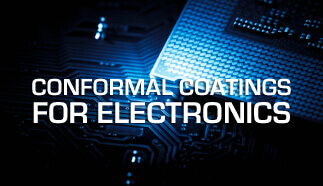<< View SCS Blog
Best Electronics Coatings
Available in five basic material types, conformal coatings serve as adaptable protective and insulating films for electronics. However, selecting the most suitable type can be difficult. Clearly defining the performance parameters of the components to be coated is crucial to determine the optimal conformal film material that aligns with the unit’s functional needs. An accurate evaluation of environmental conditions, such as expected levels of corrosion, exposure to foreign particles, moisture/salt spray concentrations, temperature fluctuations and vibrational range, is essential in choosing the ideal coating type for your electronics’ applications. Without adequate protection, printed circuit boards (PCBs) and similar electronic components are vulnerable and may not withstand harsh environmental conditions.

Coating Materials
There are four types of liquid conformal coating materials: acrylic, epoxy, silicone and urethane. Liquid coatings are applied to substrate surfaces by wet brush, immersion (dipping the component in a tank of liquid film material) or spray methods, which are relatively simple and inexpensive to enact; when used correctly, each coating material offers generally dependable external coating protection for electronic devices.
Parylene conformal coating is applied as a gas through chemical vapor deposition (CVD). Parylene’s unique application process generates superior coating protection in most cases. Through CVD, solid Parylene dimer is converted into a gas that penetrates crevices and tight areas on multi-layer components, providing complete and uniform encapsulation.
To be successful, conformal coating selection should depend on what coating material and application method provides the necessary performance benefits for the assembly’s end use and operational environment.
Choosing the Right Conformal Coating
Each coating material functions optimally under specific conditions, which guide their use for electronics.
Acrylic: Typically applied at thickness between 0.002 – 0.005 inches, fungus-resistant acrylic is easily applied and dries in as little as 30 minutes at room temperature, making it a good choice if the objective is rapid production. However, the fact that it cannot withstand temperatures above 125°C negates acrylic’s uses for electronics expected to perform in higher-heat environments.
Epoxy: In comparison to other liquid film materials, epoxy offers exceptional coating strength, dependably resisting abrasion, chemical incursion, humidity and vibration. Unfortunately, this same long-lasting surface durability also makes epoxy coatings very difficult to rework and repair. Epoxy can shrink during polymerization. These two factors make exceptionally careful film application a necessity. Temperature extremes diminish its stress resistance, further limiting epoxy’s use for electronics.
Silicone: In contrast to both acrylic and epoxy, silicone conformal coatings maintain high-level performance in high temperature environments that exceed 200°C, making them a good choice for automotive electronics. Silicone responds well to thicker-layer application, reliably diminishing the impact of operational vibration on the functioning of electronic components. While it offers good resistance to corrosion and humidity, silicone has lower resistance to abrasion and solvents than other conformal films, limiting electronics uses.
Urethane: Providing dependable dielectric functioning for extended periods, urethane supports MEMS/nano miniaturization through enhanced insulation of electronic signal traces from circuits situated in close proximity on a PCB. Urethane also withstands chemical solvents, delivers humidity resistance and mitigates development of tin whiskers on components. However, the benefits of solvent-resistance are somewhat minimized by difficulty reworking/removing the coatings, which also suffer from limited functionality under high-heat and high-vibration operating conditions.
Parylene: CVD-applied, non-liquid Parylene provides a more comprehensive level of quality protection for electronics. Delivering consistent and continuous uniform, pinhole-free conformal films, the deposition process enables gaseous Parylene to permeate within most substrate materials: ceramic, ferrite, glass, metal, paper, plastics and resin. The same quality allows the coating to adaptat to any shape on the unit’s surface without the pooling or dripping typical of liquid coating materials; corners, crevices, edges and even internal spaces are protected by Parylene, which deposits as a durable, micro-thin film. Chemical inertness, a low dielectric constant and high dielectric strength enhance its utility for a wide range of electronic devices. Adaptable for MEMS/nano technology, Parylene protects circuits from electrical interference while allowing the design of smaller, more compact boards. However, Parylene can be expensive and difficult to rework; batch-sizes may be smaller compared to other conformal coatings.
All conformal coatings offer some level of security for electronics. However, the degree of protection depends on the coating material used, its method of application, the function of the electronic device and its operational environment.

